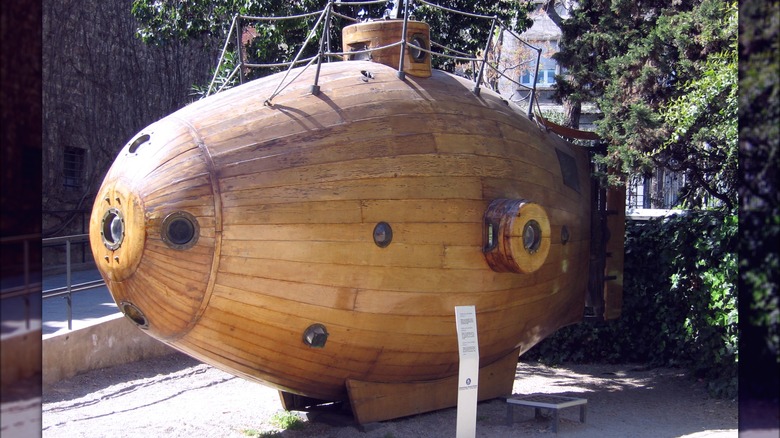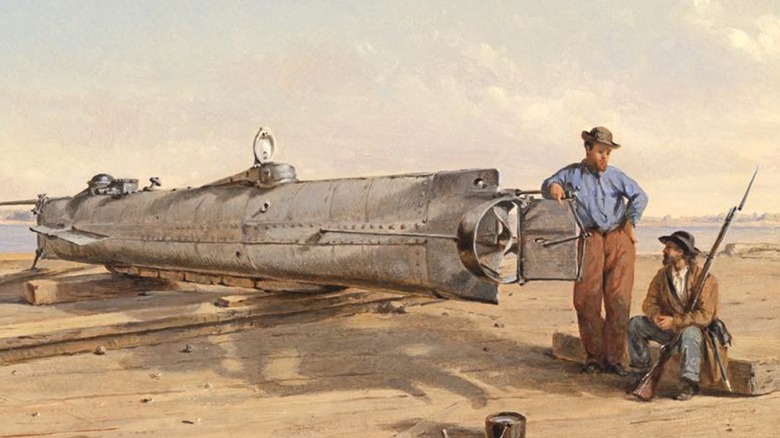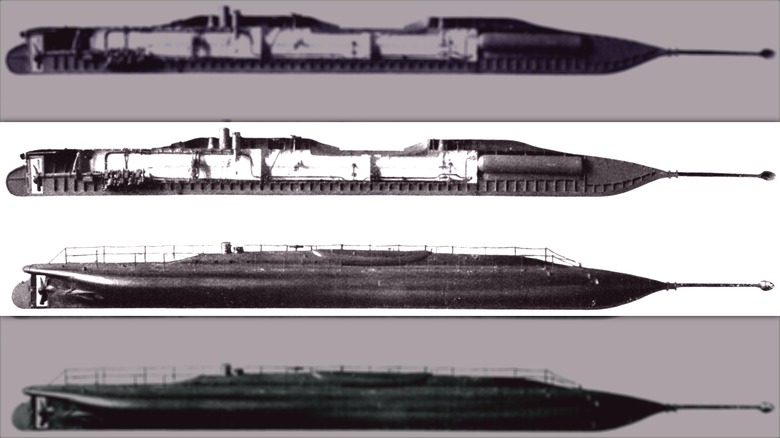5 Early Submarines That Navigated The Depths Before The 1900s
When people think about submarines, they often recall the modern variety: massive vessels housing dozens of people, incredible weaponry, and advanced technology. That's certainly true of contemporary submarines like the U.S. Ohio-class ballistic missile subs, but they represent the result of centuries of development. The first submarines didn't come about during World War II, nor did they first appear during World War I — subs actually go back to the 1600s.
Since then, the technology has improved drastically, but like any nascent tech, it took a long time for advances to be made, resulting in the types of submarines we have today. Since the first subs sailed in the 17th century, attempts were made to perfect the technology in the centuries that followed.
Subs were designed as proofs of concept for military operations, exploration, and scientific pursuits. While subs today aren't unusual, they were pretty strange for a few hundred years, and not every sub design proved effective. There was a lot of trial and error that extended for centuries, involving people from all over the world. Their work ultimately prevailed in the evolution of naval warfare via the submarine technology we have today, and these five early examples all navigated the depths before the 1900s.
[Featured image by U.S. Navy via Wikimedia Commons | Cropped and scaled | Public Domain]
The Drebbel
While people had considered underwater travel for centuries dating back to ancient times, the first confirmed successful submarine didn't arrive until 1620. Cornelius Van Drebbel designed and built the first submarine while working for King James I of England. Drebbel built his vessel, which was propelled via oars. Unfortunately, there is no accurate historical account of its specs, as no records of Drebbel's survived.
Still, some things are known about the subs through the writings of observers at the time. Drebbel tested it in the River Thames in 1620. Accounts of its design indicate the submarine was created from two rowboats, one fastened atop the other to create the Drebbel's structure. Several oars were positioned port and starboard, jutting out from the inside through watertight seals to help steer and drive the boat. To submerge and resurface, special bladders acted as a ballast system that allowed for water to be taken in and released, while air from the surface was delivered through tubing. Constantijn Huygens described the test, noting that the boat submerged for three hours, leading the observers to assume the worst.
Fortunately, the worst didn't happen, and the sub resurfaced far from where it dove. During the test, the sub went to the river bottom, where it remained before surfacing. Hyugens wrote, "Yea, even that they had done in the belly of that whale all the things people are used to do in the air, and this without any trouble." At the time, Drebbel hoped to militarize submarines for the Royal Navy, but they didn't adopt it, and Drebbel was dismissed from the court. While his design wasn't used, it established the basis of what worked.
[Featured image by Unknown via Wikimedia Commons | Cropped and scaled | Public Domain]
The Turtle
American inventor David Bushnell and Isaac Doolittle got into the submarine designing game during the American Revolutionary War. In 1775, Bushnell and Doolittle designed a new type of submersible for a single occupant with the sole goal of deploying underwater explosives to lift the British blockade of Boston. Construction on the design of what is now known as "the Tuttle" began after perfecting a method of deploying underwater explosives. Doolittle's skills as a clockmaker helped create the mechanically-triggered bomb as well as the vessel's propeller.
Unfortunately, it took too long to build, so the Turtle wasn't used to break the blockade of Boston Harbor. The British moved the blockade to New York, which is where the Americans deployed the Turtle for its first use in combat. On Sept. 6, 1776, Sgt. Ezra Lee of the Continental Army piloted the Turtle at night to attack the HMS Eagle. Unfortunately, Lee was unable to bore deep enough into the hull to deliver the bomb, and he abandoned the mission.
While the mission failed, the Turtle worked, and Lee returned safely to the surface. The Turtle saw action twice more but also failed. During the Battle of Fort Lee, the British managed to sink the Turtle by taking out the sloop transporting it. The Turtle never succeeded in sinking an enemy vessel, but it proved the concept of a submarine, and remains the first to engage in combat. While the Turtle was lost, you can visit a reproduction at the Connecticut River Museum.
[Featured image by Zenit via Wikimedia Commons | Cropped and scaled | CC BY-SA 3.0]
The Ictíneo I and Ictíneo II
Narcís Monturiol i Estarriol was a Catalin inventor and engineer who came up with a submarine concept that would be used for safe diving in coral reefs. He came up with the concept after witnessing the death of a coral diver, and when he put his idea to work, he came up with the Ictíneo I. Monturiol described his design as "that of a fish, and like a fish, it has its motor in the tail, fins to control its direction, and swimming bladders and ballast to maintain an equilibrium with the water from the moment it submerges."
What makes her distinctive is that it was the first fully functional boat of its kind. The Ictíneo I was first launched on June 28, 1859, in the waters of Barcelona harbor. The sub slipped under the waves and surfaced 20 minutes later. The sub could remain submerged for up to two hours before needing to return to the surface. She completed 20+ dives and was ultimately destroyed in 1862 when she ran into a cargo ship.
Unwilling to call it quits, Monturiol built the Ictíneo II in 1864. Improvements made it able to submerge for longer and dive deeper, but most notable was its means of propulsion. Monturiol invented an anaerobic steam engine, which he fitted into the boat. His invention made the Ictíneo II the first submarine powered by a steam engine. Unfortunately, this limited the sub's operation due to issues related to heat, and the Ictíneo II wasn't as successful as its predecessor.
[Featured image by Till F. Teenck via Wikimedia Commons | Cropped and scaled | CC BY-SA 2.5]
The CSS Hunley
During the American Civil War, both sides fielded submarines with the Confederates launching the CSS Hunley in 1863. This was an important development in the advancement of submarine technology, as it was the first to successfully sink a warship. She wasn't the first submarine used during the Civil War, but the Hunley remains an important undersea boat due to its impact on naval history.
The Hunley was paid for privately by its inventor, Horace Lawson Hunley, and was constructed from iron with cast iron fittings. She was piloted by a single man, while seven more would operate the hand crank attached to the propeller. The Hunley's forward and aft compartments served as ballast tanks, where water could be manually pumped in or out for diving and surfacing. The Hunley entered the sea and found herself a target on the evening of February 17, 1864.
The Hunley approached the USS Housatonic while it served on blockade duty outside the entrance to Charleston Harbor, South Carolina. She was armed with a torpedo bolted onto a 16-foot spar, which was slammed into the Housatonic below the water, detonating. The Housatonic suffered a fatal blow to her hull, and she sank to the bottom. Unfortunately, the attack also took out the Hunley. Her wreck was discovered 131 years later, and the Hunley was recovered and is on display in North Charleston, South Carolina.
[Featured image by Conrad Wise Chapman via Wikimedia Commons | Cropped and scaled | Public Domain]
The Plongeur
As submarine development improved, one thing that desperately needed advancement was propulsion. Most submarines developed before the 20th century required raw manpower to move the vessel underwater, but that all changed when French Capt. Siméon Bourgeois' designed a new system in the early 1850s. Bourgeois developed the Plongeur, the first submarine to use mechanized propulsion successfully. The Plongeur overcame did this via compressed air engine powered by compressed air.
This was accomplished via onboard tanks, which took up most of the internal space of the Plongeur. Despite this encumbrance, the Plongeur's complement included 12 submariners. Like the CSS Hunley, she was armed with spar torpedoes, and a ram. The vessel even included a lifeboat for all personnel onboard, and it measured 140 feet in length, displacing 420 tons of seawater. She wasn't a small ship, and the Plongeur's many advancements helped move submarine development forward.
The Plongeur began its sea trials in 1863, and the results were mixed. While it demonstrated numerous technological advancements, it had several issues that made the Plongeur untenable for military use. The boat left a noticeable wake while submerged, making it easy to spot. It also required a trailing support surface ship, and she was deemed unsuitable for the military. Four years after she launched, the Plongeur was decommissioned and transformed into a tank vessel in 1873. She continued operating all the way until she was finally decommissioned on Christmas day, 1935.
[Featured image by Hohum via Wikimedia Commons | Cropped and scaled | Public Domain]





